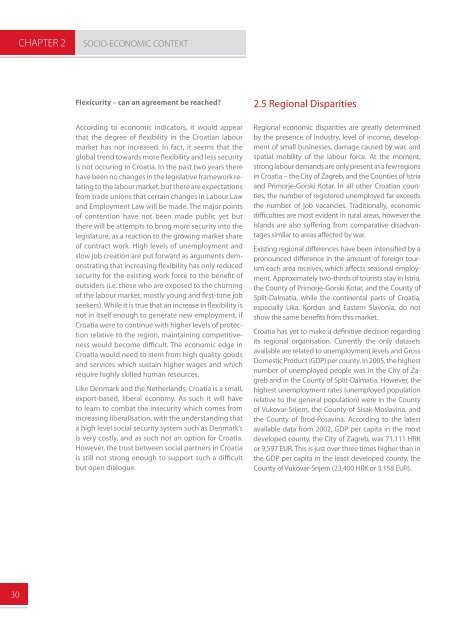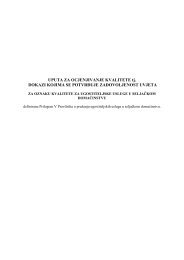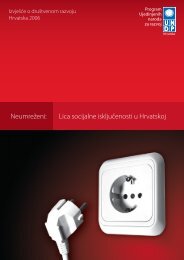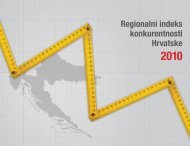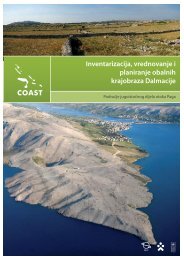WEB engleska verzija end.indd - UNDP Croatia
WEB engleska verzija end.indd - UNDP Croatia
WEB engleska verzija end.indd - UNDP Croatia
- No tags were found...
You also want an ePaper? Increase the reach of your titles
YUMPU automatically turns print PDFs into web optimized ePapers that Google loves.
CHAPTER 2SOCIO-ECONOMIC CONTEXTFlexicurity – can an agreement be reached?According to economic indicators, it would appearthat the degree of flexibility in the <strong>Croatia</strong>n labourmarket has not increased. In fact, it seems that theglobal tr<strong>end</strong> towards more flexibility and less securityis not occuring in <strong>Croatia</strong>. In the past two years therehave been no changes in the legislative framework relatingto the labour market, but there are expectationsfrom trade unions that certain changes in Labour Lawand Employment Law will be made. The major pointsof contention have not been made public yet butthere will be attempts to bring more security into thelegislature, as a reaction to the growing market shareof contract work. High levels of unemployment andslow job creation are put forward as arguments demonstratingthat increasing flexibility has only reducedsecurity for the existing work force to the benefit ofoutsiders (i.e. those who are exposed to the churningof the labour market, mostly young and first-time jobseekers). While it is true that an increase in flexibility isnot in itself enough to generate new employment, if<strong>Croatia</strong> were to continue with higher levels of protectionrelative to the region, maintaining competitivenesswould become difficult. The economic edge in<strong>Croatia</strong> would need to stem from high quality goodsand services which sustain higher wages and whichrequire highly skilled human resources.Like Denmark and the Netherlands, <strong>Croatia</strong> is a small,export-based, liberal economy. As such it will haveto learn to combat the insecurity which comes fromincreasing liberalisation, with the understanding thata high level social security system such as Denmark’sis very costly, and as such not an option for <strong>Croatia</strong>.However, the trust between social partners in <strong>Croatia</strong>is still not strong enough to support such a difficultbut open dialogue.2.5 Regional DisparitiesRegional economic disparities are greatly determinedby the presence of industry, level of income, developmentof small businesses, damage caused by war, andspatial mobility of the labour force. At the moment,strong labour demands are only present in a few regionsin <strong>Croatia</strong> – the City of Zagreb, and the Counties of Istriaand Primorje-Gorski Kotar. In all other <strong>Croatia</strong>n counties,the number of registered unemployed far exceedsthe number of job vacancies. Traditionally, economicdifficulties are most evident in rural areas, however theislands are also suffering from comparative disadvantagessimilar to areas affected by war.Existing regional differences have been intensified by apronounced difference in the amount of foreign tourismeach area receives, which affects seasonal employment.Approximately two-thirds of tourists stay in Istria,the County of Primorje-Gorski Kotar, and the County ofSplit-Dalmatia, while the continental parts of <strong>Croatia</strong>,especially Lika, Kordun and Eastern Slavonia, do notshow the same benefits from this market.<strong>Croatia</strong> has yet to make a definitive decision regardingits regional organisation. Currently the only datasetsavailable are related to unemployment levels and GrossDomestic Product (GDP) per county. In 2005, the highestnumber of unemployed people was in the City of Zagreband in the County of Split-Dalmatia. However, thehighest unemployment rates (unemployed populationrelative to the general population) were in the Countyof Vukovar-Srijem, the County of Sisak-Moslavina, andthe County of Brod-Posavina. According to the latestavailable data from 2002, GDP per capita in the mostdeveloped county, the City of Zagreb, was 71,111 HRKor 9,597 EUR. This is just over three times higher than inthe GDP per capita in the least developed county, theCounty of Vukovar-Srijem (23,400 HRK or 3,158 EUR).30


